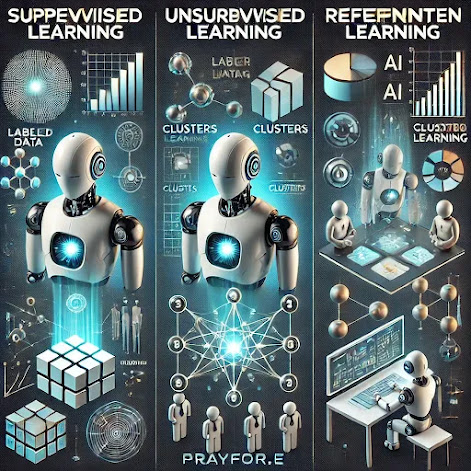🏆 Reinforcement Learning vs. Supervised Learning vs. Unsupervised Learning: How Does AI Learn? 🤖📚
Artificial Intelligence (AI) is revolutionizing industries, but have you ever wondered how AI actually learns? 🤔
There are three main ways AI models are trained:
Supervised Learning, Unsupervised Learning, and Reinforcement Learning.
Each method has unique approaches, strengths, and real-world applications. Let’s dive into how these learning methods shape the future of AI! 🚀
1️⃣ Supervised Learning: Learning with a Teacher 📘👨🏫
Supervised Learning is like learning with a teacher who provides the right answers.
In this method, the model is trained on a labeled dataset, meaning each input comes with the correct output.
🔍 How It Works:
- Input: The model receives data with labels.
- Training: It learns to map inputs to the correct outputs.
- Prediction: Once trained, it can predict outcomes for new data.
💼 Real-World Applications:
- Email Spam Detection: Identifying spam vs. non-spam emails. 📧
- Face Recognition: Tagging friends in photos. 📸
- Stock Price Prediction: Predicting market trends. 📈
✅ Pros:
- Highly accurate when trained on quality data.
- Straightforward and easy to implement.
❌ Cons:
- Requires a large, labeled dataset.
- Time-consuming to label data.
2️⃣ Unsupervised Learning: Finding Hidden Patterns 🕵️♂️🔍
Unsupervised Learning is like solving a puzzle without a picture on the box.
The AI is given unlabeled data and must discover patterns or groupings on its own.
🔍 How It Works:
- Input: Data without predefined labels.
- Training: The model looks for similarities and structures.
- Output: It organizes data into clusters or finds associations.
💼 Real-World Applications:
- Customer Segmentation: Grouping customers by purchasing habits. 🛒
- Recommendation Systems: Netflix or YouTube suggestions. 🎥
- Fraud Detection: Spotting unusual banking activity. 💳
✅ Pros:
- No need for labeled data.
- Great for discovering hidden patterns.
❌ Cons:
- Hard to evaluate accuracy.
- Results can be unpredictable.
3️⃣ Reinforcement Learning: Learning by Trial and Error 🎮🏆
Reinforcement Learning (RL) is like training a dog with treats.
The AI learns by interacting with its environment, receiving rewards for good actions and penalties for mistakes.
🔍 How It Works:
- Agent: The AI making decisions.
- Environment: Where the AI operates.
- Rewards/Penalties: Positive or negative feedback for actions.
💼 Real-World Applications:
- Game AI: AlphaGo defeating world champions. ♟️
- Robotics: Robots learning to walk. 🤖
- Self-Driving Cars: Learning safe driving habits. 🚗
✅ Pros:
- Excels in dynamic environments.
- Learns complex tasks over time.
❌ Cons:
- Requires lots of time and computing power.
- Can make risky decisions during training.
📊 Comparison at a Glance
🔥 Which Learning Method Is Best?
There’s no one-size-fits-all answer. The choice depends on the task!
- Supervised Learning is best for structured tasks like classification.
- Unsupervised Learning shines when discovering new insights.
- Reinforcement Learning is perfect for tasks requiring decision-making over time.
In many cases, hybrid approaches combine these methods for even better results! 🔄
💥 Final Thoughts: Unlocking AI’s Full Potential 💥
AI’s ability to learn from data is the foundation of its incredible power.
Whether it’s recognizing faces, suggesting movies, or mastering complex games, understanding these learning methods gives us insight into how AI will continue to evolve. 🌐
Are you ready to explore more about how AI learns and changes the world? 🌍
🚀 Let’s Discover AI Together!
#AI #DL #ML #LLM #IT #ArtificialIntelligence #MachineLearning #SupervisedLearning #UnsupervisedLearning #ReinforcementLearning #AITraining #TechInnovation




No comments:
Post a Comment